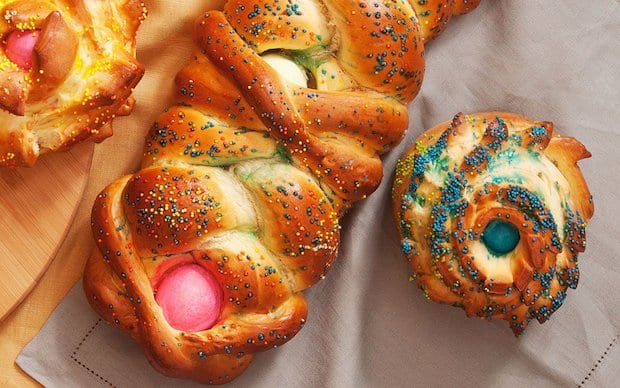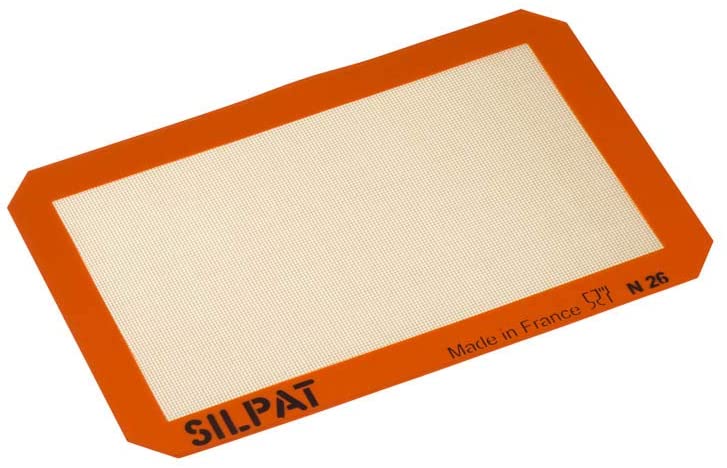Not only does this beautiful Italian Easter Egg Bread recipe add a holiday flair to an Easter meal with colored Easter eggs, it tastes GOOD too!


If you have ever spent Easter in an Italian-American household, it’s likely you may have seen a pretty braided bread featuring colored Easter Eggs gracing the table.
Not only does the bread add a beautiful Easter flair to a special holiday meal, it tastes GOOD too!

This Colored Easter Egg Bread Recipe comes to us from Chef Sal Scognamillo of Patsy’s Italian Restaurant in New York City.
While the Italian Easter egg bread I have had at Easter meals has always come from the bakery, Chef Sal’s recipe makes it easy enough for you to bake at home.
Colored Easter Egg Bread Recipe
Makes 1 Large Loaf, About 10 Servings
*Can be found in Patsy’s Italian Family Cookbook
Ingredients
SWEET DOUGH
- 1 cup whole milk
- ½ cup sugar
- 2 large eggs
- 1 tablespoon instant (also called bread-machine) yeast
- Finely grated zest of 1 lemon
- 2 teaspoons anise seeds
- 1 ½ teaspoons salt
- 5 cups unbleached all-purpose flour, as needed
- 6 tablespoons (3/4 stick) unsalted butter, cut into tablespoons, at room temperature, plus softened butter for the bowl
MISC
- 6 colored eggs (see Note)
- 1 large egg yolk beaten with 1 teaspoon whole milk, for glaze
- 2 teaspoons nonpareils (colored sugar decorations) for garnish
Frontier Natural Products Anise Seed




🥣 How to Make
- To make the sweet dough: combine the milk, sugar, eggs, yeast, lemon zest, anise seeds, and salt together in the bowl of a heavy-duty stand mixer. Mix with the paddle attachment on low speed until combined. Gradually add 3 ½ cups of the floor to make a thick batter. One tablespoon at a time, beat in the butter, waiting for the first addition to be absorbed before adding more. Gradually add enough of the remaining flour to make a soft dough that cleans the bowl. Switch to the dough hook and mix on medium-low speed, occasionally pulling down the dough as it climbs up the hook, until the dough is smooth, shiny, and slightly sticky (do not add too much flour), about 8 minutes.
To make the dough by hand: whisk the milk, sugar, eggs, yeast, lemon zest, anise seeds, and salt together in a large bowl. Gradually stir in 3 ½ cups of the flour to make a thick batter. One tablespoon at a time, stir in the butter, waiting for the first addition to be absorbed before adding more. Gradually stir in enough of the remaining flour to make a dough that cannot be stirred. Turn the dough out onto a lightly floured work surface and knead, adding more flour as necessary, until the dough is smooth, supple, and slightly sticky (do not add too much flour), about 10 minutes.
2. Butter a large bowl. Gather the dough into a ball. Turn the dough in the bowl to coat it, leaving the dough smooth side up. Cover tightly with plastic wrap and let stand in a warm place until doubled in volume, about 1 ¼ hours. (Or refrigerate the dough for at least 8 and up to 24 hours.)
3. Line a large rimmed baking sheet with parchment paper or use a Silpat baking mat. Divide the dough into thirds. Roll each piece of dough underneath your palms on the work surface into an 20-inch rope, tapering the ends. Line up the ropes next to each other. Starting from the center, braid the ropes to each end, pinching the rope ends together to shape into a tapered loaf. Transfer the braid to the parchment paper-lined baking sheet. Cover loosely with plastic wrap. Let stand in a warm draft-free place until almost doubled in volume, about 1 hour (or about 1 ½ hours for chilled dough). During the last 15 minutes of rising, distribute the eggs evenly over the top of the braid, nesting them in the seams.
4. Preheat the oven to 350⁰F
5. Brush the braid lightly with the egg glaze and sprinkle with the nonpareils. Bake until the loaf is golden brown and sounds hollow when tapped on the bottom, about 30 minutes. Let cool completely before slicing.
How to Color Eggs for Easter Egg Bread
To color the eggs, you can use a pre-packaged coloring set, or make your own egg color.
For each shade, combine 1 ½ cups boiling water and 1 teaspoon white distilled vinegar in a large glass.
Tint the liquid as desired with food coloring gel (which has deeper colors than liquid coloring, although you can use liquid).
Dip each hard-boiled egg in the coloring mixture, and let stand for at least 2 minutes, or until the desired color is reached.
Remove the egg from the coloring mixture and let dry on a wire cooling rack set over a baking sheet.

Colored Easter Egg Bread
Equipment
Ingredients
- 1 cup whole milk
- ½ cup sugar
- 2 large eggs
- 1 tablespoon instant also called bread-machine yeast
- Finely grated zest of 1 lemon
- 2 teaspoons anise seeds
- 1 ½ teaspoons salt
- 5 cups unbleached all-purpose flour as needed
- 6 tablespoons 3/4 stick unsalted butter, cut into tablespoons, at room temperature, plus softened butter for the bowl
- 6 colored eggs see Note
- 1 large egg yolk beaten with 1 teaspoon whole milk for glaze
- 2 teaspoons nonpareils colored sugar decorations for garnish
Instructions
- To make the sweet dough: combine the milk, sugar, eggs, yeast, lemon zest, anise seeds, and salt together in the bowl of a heavy-duty stand mixer. Mix with the paddle attachment on low speed until combined. Gradually add 3 ½ cups of the floor to make a thick batter. One tablespoon at a time, beat in the butter, waiting for the first addition to be absorbed before adding more. Gradually add enough of the remaining flour to make a soft dough that cleans the bowl. Switch to the dough hook and mix on medium-low speed, occasionally pulling down the dough as it climbs up the hook, until the dough is smooth, shiny, and slightly sticky (do not add too much flour), about 8 minutes.
- To make the dough by hand: whisk the milk, sugar, eggs, yeast, lemon zest, anise seeds, and salt together in a large bowl. Gradually stir in 3 ½ cups of the flour to make a thick batter. One tablespoon at a time, stir in the butter, waiting for the first addition to be absorbed before adding more. Gradually stir in enough of the remaining flour to make a dough that cannot be stirred. Turn the dough out onto a lightly floured work surface and knead, adding more flour as necessary, until the dough is smooth, supple, and slightly sticky (do not add too much flour), about 10 minutes.
- Butter a large bowl. Gather the dough into a ball. Turn the dough in the bowl to coat it, leaving the dough smooth side up. Cover tightly with plastic wrap and let stand in a warm place until doubled in volume, about 1 ¼ hours. (Or refrigerate the dough for at least 8 and up to 24 hours.)
- Line a large rimmed baking sheet with parchment paper. Divide the dough into thirds. Roll each piece of dough underneath your palms on the work surface into an 20-inch rope, tapering the ends. Line up the ropes next to each other. Starting from the center, braid the ropes to each end, pinching the rope ends together to shape into a tapered loaf. Transfer the braid to the parchment paper-lined baking sheet. Cover loosely with plastic wrap. Let stand in a warm draft-free place until almost doubled in volume, about 1 hour (or about 1 ½ hours for chilled dough). During the last 15 minutes of rising, distribute the eggs evenly over the top of the braid, nesting them in the seams.
- Preheat the oven to 350?F
- Brush the braid lightly with the egg glaze and sprinkle with the nonpareils. Bake until the loaf is golden brown and sounds hollow when tapped on the bottom, about 30 minutes. Let cool completely before slicing.













Melissa says
Hi, I am also an Italian American mom and grandmom (meme, actually) AND I LOVE holidays mostly because I get to cook lots of family favorites in larger than normal portions.
Today, sadly, we are under lock down due to an un-godly virus, so I am kinda afraid to venture out too much. How do I work around not having INSTANT yeast and still get the same result? I have plenty of “regular” refrigerated yeast.
thanks!
Chrysa says
With active dry yeast, you need to dissolve in water before adding to the recipe. Here are some tips: https://www.thekitchn.com/whats-the-difference-between-active-dry-yeast-and-instant-yeast-54252
Kelly L. says
I made this bread for Easter 2019. It was delicious and wonderfully aromatic! I made by hand (no stand mixer) and the only change was using 1 Tbsp anise seed. I used cooked eggs that my 3yo son and I colored the day before. The flavor is delicious and the bread itself is really beautiful. My husband ate one of the in-bread eggs this morning and it was just fine. Thanks for putting directions on how to make with both a stand mixer and by hand, as I had some trouble finding a recipe to make by hand and really wanted to make this beautiful bread into an Easter tradition for my family.
Chrysa says
Hi, Kelly. I’m so happy that the recipe worked well for you. Thanks for sharing your results!
Marcie W. says
Being part Italian, I am fairly surprised this is my first time learning about colored Easter egg bread. I love the look of the finished product and bet it tastes amazing too!
Heidi says
What a fun recipe, Chrysa. I had the same question about boiling the eggs first. So the eggs don’t get extra hard when they are already boiled and then baked again with the bread? My kids would love this!
Scott says
We’ve made bread wraps before, but not anything that colorful. Wonderful Easter idea!
Marysa says
Very pretty! I would love to try to make this Easter egg bread. I have seen similar breads but I have yet to try making them. I’ll have to make this with the kids!
TamTam says
Are the eggs boiled before coloring and baking, or are they colored raw?
Chrysa says
They are boiled first.
Irina David says
This bread looks incredible! And so colorful
Amy Tolley says
Amazing looking bread thanks for sharing this recipe with us such a colorful bread…